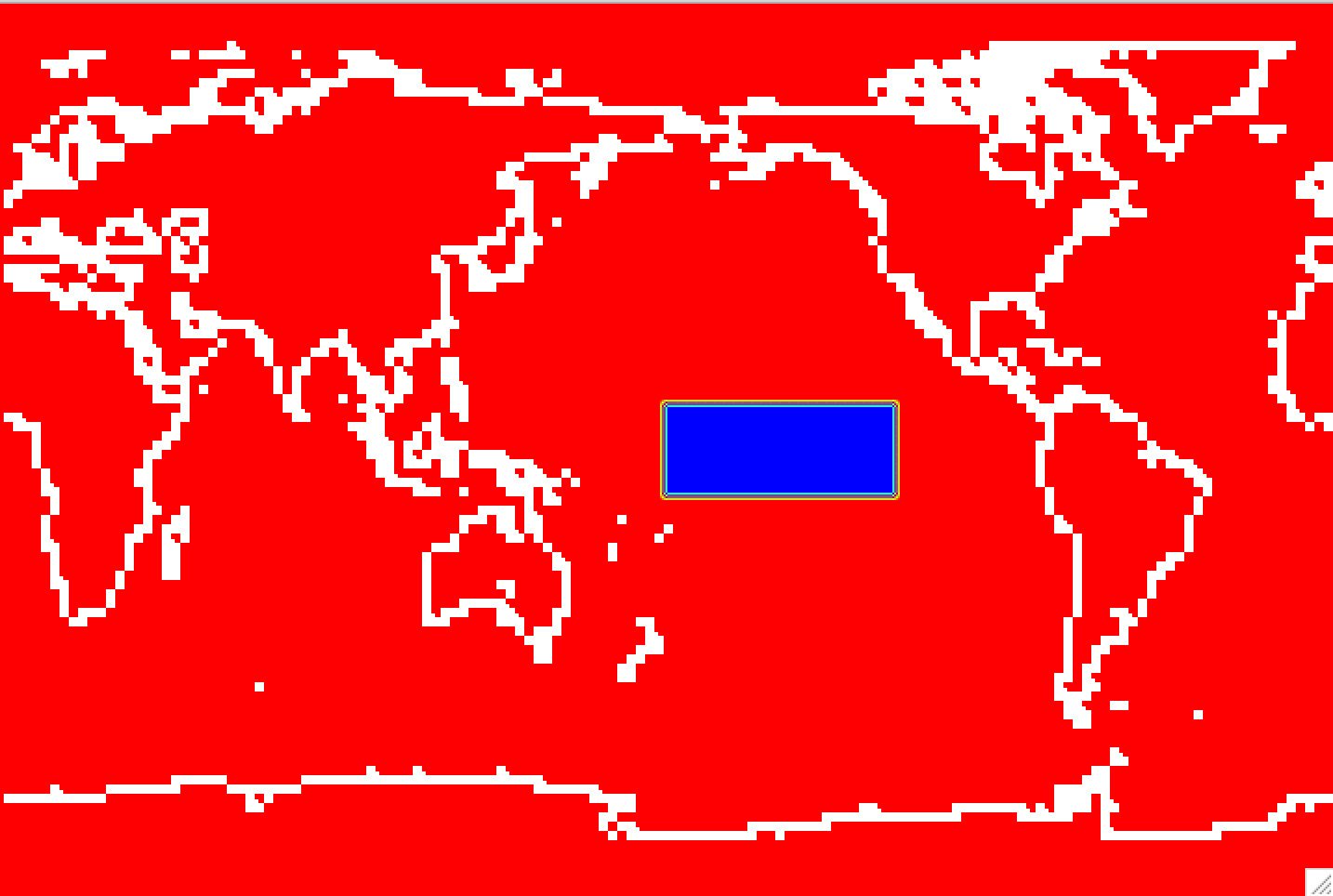5: Modify sea surface temperature in the tropics#
Change input boundary datasets (Sea Surface Temperature) by increasing its value by 2K in the tropical Central Pacific.
Create a case similar to control case but change input boundary datasets (Sea Surface Temperature) by increasing its value by 2K in the tropical Central Pacific.

Figure: Increase orographic height over the western US.
Create, configure, build and run a case called f2000.sst with the compset F2000climo at the resolution f19_f19_mg17 using the same history file output as in the control. Change the SST input datasets
Run for 5 days.
Click here for hints
How do I output 3 hourly instantaneous variables?
Use namelist variables:
nhtfrq,mfilt,fincl.For more information, look at the chapter:
NAMELIST MODIFICATIONS -> Customize CAM output
Where do I change the SST dataset?
Look at the xml variable
SSTICE_DATA_FILENAME
Click here for the solution
# Set environment variables
Set environment variables with the commands:
tcsh user
set CASENAME=f2000.sst
set CASEDIR=/glade/u/home/$USER/cases/$CASENAME
set RUNDIR=/glade/derecho/scratch/$USER/$CASENAME/run
set COMPSET=F2000climo
set RESOLUTION=f19_f19_mg17
bash user
export CASENAME=f2000.sst
export CASEDIR=/glade/u/home/$USER/cases/$CASENAME
export RUNDIR=/glade/derecho/scratch/$USER/$CASENAME/run
export COMPSET=F2000climo
export RESOLUTION=f19_f19_mg17
# Create a new case
Create a new case with the command create_newcase:
cd /glade/u/home/$USER/code/my_cesm_code/cime/scripts/
./create_newcase --case $CASEDIR --res $RESOLUTION --compset $COMPSET
# Change the job queue and account number
If needed, change job queue and account number.
For instance, to run in the queue tutorial and the project number UESM0014. You should use the project number given for this tutorial.
cd $CASEDIR
./xmlchange JOB_QUEUE=tutorial,PROJECT=UESM0014 --force
This step can be redone at anytime in the process.
# Setup
Invoke case.setup with the command:
cd $CASEDIR
./case.setup
# Modify orography
Copy the SST file into your case directory and modify it over there.
Here we use the nco operators but feel free to use any other tool that you familiar with.
cd $CASEDIR
cp /glade/campaign/cesm/cesmdata/cseg/inputdata/atm/cam/sst/sst_HadOIBl_bc_1.9x2.5_2000climo_c180511.nc .
ncap2 -O -s 'lat2d[lat,lon]=lat ; lon2d[lat,lon]=lon' \
-s 'omask=(lat2d >= -10. && lat2d <= 10.) && (lon2d >= 180. && lon2d <= 240.)'\
-s 'SST_cpl=(SST_cpl+omask*2.)' sst_HadOIBl_bc_1.9x2.5_2000climo_c180511.nc \
sst_HadOIBl_bc_1.9x2.5_2000climo_c180511.nc.warmtcp.nc
# Visualize your modification to orography
You could create a file diff_sst.nc with the differences of SST ncdiffand then visualize the that file with ncview. You also welcome to use your own tools to visualize your mods to orography.
Create a file
diff_sst.ncwith the differences in SSTs:
ncdiff \
sst_HadOIBl_bc_1.9x2.5_2000climo_c180511.nc \
sst_HadOIBl_bc_1.9x2.5_2000climo_c180511.nc.warmtcp.nc \
diff_sst.nc
Look at the
diff_sst.ncwithncview:
ncview diff_sst.nc

Figure: View the increase in orographic height over the western US with ncview.
# Point to the new SST file
./xmlchange SSTICE_DATA_FILENAME="$CASEDIR/sst_HadOIBl_bc_1.9x2.5_2000climo_c180511.nc.warmtcp.nc"
# Customize namelists
Edit the file user_nl_cam and add the lines:
nhtfrq(2) = -3
mfilt(2) = 240
fincl2 = 'TS:I','PS:I', 'U850:I','T850:I','PRECT:I','LHFLX:I','SHFLX:I','FLNT:I','FLNS:I'
You can do this with a text editor. Alternatively, you can use the echo command:
echo "nhtfrq(2) = -3">> user_nl_cam
echo "mfilt(2) = 240">> user_nl_cam
echo "fincl2 = 'TS:I','PS:I', 'U850:I','T850:I','PRECT:I','LHFLX:I','SHFLX:I','FLNT:I','FLNS:I'">> user_nl_cam
echo "">> user_nl_cam
You build the namelists with the command:
./preview_namelists
This step is optional as the script preview_namelists is automatically called by case.build and case.submit. But it is nice to check that your changes made their way into:
$CASEDIR/CaseDocs/atm_in
# Set run length
If needed, change the run length. If you want to run 5 days, you don’t have to do this, as 5 days is the default.
./xmlchange STOP_N=5,STOP_OPTION=ndays
# Build and submit:
qcmd -- ./case.build
./case.submit
# Check your solution
When the run is completed, look at the history files into the archive directory.
(1) Check that your archive directory on derecho (The path will be different on other machines):
cd /glade/derecho/scratch/$USER/archive/$CASENAME/atm/hist
ls
As your run is only 5-day, there should be no monthly file (h0)
(2) Look at the contents of the h1 files using ncdump.
The file should contain the instantaneous output in the file
h1for the variables:
float FLNS(time, lat, lon) ;
FLNS:Sampling_Sequence = "rad_lwsw" ;
FLNS:units = "W/m2" ;
FLNS:long_name = "Net longwave flux at surface" ;
float FLNT(time, lat, lon) ;
FLNT:Sampling_Sequence = "rad_lwsw" ;
FLNT:units = "W/m2" ;
FLNT:long_name = "Net longwave flux at top of model" ;
float LHFLX(time, lat, lon) ;
LHFLX:units = "W/m2" ;
LHFLX:long_name = "Surface latent heat flux" ;
float PRECT(time, lat, lon) ;
PRECT:units = "m/s" ;
PRECT:long_name = "Total (convective and large-scale) precipitation rate (liq + ice)" ;
float PS(time, lat, lon) ;
PS:units = "Pa" ;
PS:long_name = "Surface pressure" ;
float SHFLX(time, lat, lon) ;
SHFLX:units = "W/m2" ;
SHFLX:long_name = "Surface sensible heat flux" ;
float T850(time, lat, lon) ;
T850:units = "K" ;
T850:long_name = "Temperature at 850 mbar pressure surface" ;
float TS(time, lat, lon) ;
TS:units = "K" ;
TS:long_name = "Surface temperature (radiative)" ;
float U850(time, lat, lon) ;
U850:units = "m/s" ;
U850:long_name = "Zonal wind at 850 mbar pressure surface" ;
Note that these variables have no cell_methods attribute becasue the output is instantaneous.
